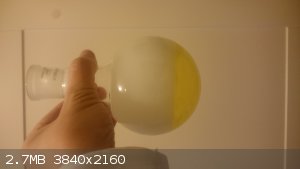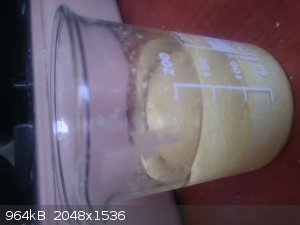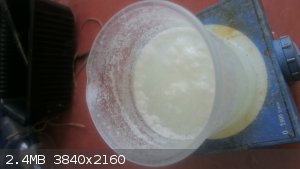Tsjerk
International Hazard
    
Posts: 3022
Registered: 20-4-2005
Location: Netherlands
Member Is Offline
Mood: Mood
|
|
4-chlorocinnamic acid synthesis without distillation
4-chlorobenzaldehyde (66 gram, 0.47 mol) is dissolved in an excess of acetone (150ml, 2 mol). 1% NaOH (290 ml, 0.073 mol) is added slowly while
maintaining a temperature between 20 and 30 degrees*.
After addition of little of the NaOH solution a snow-white precipitate start to form, presumably the benzaldehyde, but soon a phase separation is
observed. This is speculated to be the 4-chlorobenzilideneacetone in acetone, as the separation comes with the appearance of a yellow color [photo 1]

The organic phase starts as a small separation on the bottom of the reaction and some droplets at the surface, but grows in volume when the reaction
proceeds.
The mixture was shaken occasionally for 5 days, about 2-3 times a day (my last, small, stir bar wasn’t capable of handling the two phase system).
Instead of vacuum distillation of the crude product as suggested in [1], no further work-up is performed. The crude product is separated under the
water layer after cooling down [photo 2]. This procedure doesn’t seem to influence the final yield or purity of the 4-chlorocinnamic acid after step
two, only the workup is slightly altered.
The crude product is molten under 2% NaOH (5 gram per 50ml 2% NaOH, 50 degrees) and cooled to RT while vigorously (magnetically) stirring. To the
obtained suspension of small beads 50 ml of 12.5% sodium hypochlorite is added. The mixture is left to stir for an hour and then heated until the
solids in the suspension melt and stirring is maintained for a further half hour. This process is repeated, while heating 10 degrees more compared to
the last heating until 100 degrees is reached**. All undissolved organics are now filtered of and the filtrate is left to cool. The solution is
acidified to pH = 1 with 20% sulfuric acid and cooled on ice [photo 3], filtered and washed with cold water until filtrate is neutral. Yield: 75%.
Mp: >248 degrees.
The product is snow white and pure as the impurities don't seem to dissolve in 2% NaOH / 1M NaOCl.
*4-chlorobenzaldehyde seems to react more slowly compared to benzaldehyde, so 30 degrees is fine in my opinion, compared to the 10 degrees in [1].
**One could try to go to 100 degrees in one go after the initial first hour. I don’t think it will matter much. This method was mainly used because
I don’t have a magnetic stirrer with a heating element.
[1] https://sci-hub.tw/https://doi.org/10.1002/jccs.195600011
[Edited on 18-7-2019 by Tsjerk]
|
|
|
Tsjerk
International Hazard
    
Posts: 3022
Registered: 20-4-2005
Location: Netherlands
Member Is Offline
Mood: Mood
|
|
[Photo 2]

[Edited on 18-7-2019 by Tsjerk]
|
|
|
Tsjerk
International Hazard
    
Posts: 3022
Registered: 20-4-2005
Location: Netherlands
Member Is Offline
Mood: Mood
|
|
[Photo 3]

[Edited on 18-7-2019 by Tsjerk]
|
|
|
Pumukli
National Hazard
   
Posts: 686
Registered: 2-3-2014
Location: EU
Member Is Offline
Mood: No Mood
|
|
Nice synth!
I'm curious whether the product has pleasant smell or not. 
|
|
|
Tsjerk
International Hazard
    
Posts: 3022
Registered: 20-4-2005
Location: Netherlands
Member Is Offline
Mood: Mood
|
|
Not at all... I didn't try the synth with plain benzaldehyde but the product I got doesn't smell at all. It smells a bit like cinnamon but nothing
compared to the non-clorinated versions.
I'm pretty sure the benzaldedehyde is gone as that does stink the place up
|
|
|
AvBaeyer
National Hazard
   
Posts: 644
Registered: 25-2-2014
Location: CA
Member Is Offline
Mood: No Mood
|
|
Interesting experiment. I am curious about your melting point of the presumed p-chlorocinnamic acid. The literature mp is reported to be 240-242
(Dictionary of Organic Compounds) and 248-250 (Aldrich catalog). Have you pushed your mp determination to see where your product melts? What other
information do you have to confirm the structure?
Your oxidation procedure deviates from the reference you provide. In the reference the benzalacetone and hypochlorite were mixed without mention of
any additional sodium hydroxide. Why did you suspend your p-chlorobenzalacetone in sodium hydroxide? Did you detect the production of chloroform?
AvB
|
|
|
Tsjerk
International Hazard
    
Posts: 3022
Registered: 20-4-2005
Location: Netherlands
Member Is Offline
Mood: Mood
|
|
AvBaeyer; Very good questions, I see I wasn't clear on the melting point. My thermometer doesn't go above 250, and I noticed it isn't very accurate at
that point either. It does melt somewhere above the suspected 248, very close to it as well, but I can't say it melts at exactly 248-250. It does melt
at least somewhere between 248 and lets say 255.
I was in doubt about what the [1] article said about the 2% NaOH; did they use hypochlorite with 2% NaOH, or did they make hypochlorite with chlorine
and 2% NaOH? See the last sentence of the article. I guessed they used 2% NaOH in addition to the hypochlorite, and as far as I can see it works.
My thoughts are that if the product that I suspect to be 4-chlorobenzalacetone is not 4-chlorobenzalacetone, it would not dissolve in NaOH as is, but
would dissolve after oxidation (I think a hot solution of hypochlorite isn't very picky in what it oxidizes). Also my product precipitates at around
pH 5, so I'm pretty sure it is an acid.
Other products could be the dibenzylideneacetone or 4-chlorobenzoic acid, the first is what I think is filtered of as the brown organic crap after the
oxidation, and the second I think is unlikely as it would require (I guess) 4-chlorobenzaldehyde before the oxidation, and this smells the place up
even in a fume hood, which it didn't. I determined the endpoint of the reaction with acetone by smell.
The final product looks like it is pure, whatever it might be, by the looks of the crystals (snow white needles) and the sharp melting point
(something slightly above 248). It does smell like cinnamon, but only lightly.
I will make the ester with methanol, this should give a melting point around 75 when it is actually 4-chlorocinnamic acid. methyl 4-chlorobenzoate
melts lower.
Edit: I didn't notice chloroform, but my reaction only runs at high temperatures, so it might have evaporated before separation. I have benzaldehyde
somewhere.... maybe it is a good idea to run the reaction with that just for the experience..
Edit2: I'm a bit reluctant to do the oxidation without NaOH, as I don't think the reaction will run at RT, and I wouldn't want to heat a solution of
NaOCl while it is forming an acid.
[Edited on 19-7-2019 by Tsjerk]
|
|
|
AvBaeyer
National Hazard
   
Posts: 644
Registered: 25-2-2014
Location: CA
Member Is Offline
Mood: No Mood
|
|
Thank you for your thoughtful reply. I have no reason to believe that you did not get your desired product. I just wanted to challenge you to be a bit
more rigorous before running off to the keyboard. By the way, the idea of making the methyl ester is a very good one. It is always good to try to
find a derivative which serves to corroborate your expectations.
Keep experimenting!
AvB
|
|
|
Tsjerk
International Hazard
    
Posts: 3022
Registered: 20-4-2005
Location: Netherlands
Member Is Offline
Mood: Mood
|
|
Thanks for the challenge! Always good to be challenged a bit when the things you say are not too convincing.
Edit: I just "dissolved" 4 grams of the product in 100 ml of hot methanol and 1 ml of sulfuric acid. The product doesn't fully dissolve but I hope the
remainder does in a couple of days when some of the product has reacted. I'm running the reaction at RT, so I'm taking my time.
I will heat the reaction now and then to see how much of the original crystals remain un-dissolved. Original crystals look way different compared to
the recrystallized once after cooling down.
Edit2: after only one and a half hours no more product crystallizes after cooling down, apparently something is going on in quite a pase. I will try
the esterfication with half the amount of methanol next time.
[Edited on 20-7-2019 by Tsjerk]
[Edited on 20-7-2019 by Tsjerk]
|
|
|
AvBaeyer
National Hazard
   
Posts: 644
Registered: 25-2-2014
Location: CA
Member Is Offline
Mood: No Mood
|
|
I suggest you run 4 g of your product in 40-50 ml of methanol with 3-5 ml of H2SO4 and keep the temperature about 50 C. The reaction should be
complete in a few hours.
One thing you could do is add another 2-3 ml H2SO4 to your current reaction then distill off about 50 ml methanol. The esterification should occur
during the distillation process but may take a bit longer. When you think esterification is complete neutralize the reaction by the careful addition
of 10% NaOH. If you have some phenolphthalein add a bit to your reaction and add base until you just get a faint pink. At this point you can further
concentrate the reaction mixture, dilute with water and hopefully get the ester to crystallize or extract it into a suitable solvent. Just a thought.
AvB
|
|
|
Tsjerk
International Hazard
    
Posts: 3022
Registered: 20-4-2005
Location: Netherlands
Member Is Offline
Mood: Mood
|
|
Thank you for the suggestions, my 4gram / 100ml run just returned the starting product. I'm still not sure what it is but it is the same as what I
started with. After there was no more precipitaton of crystals upon cooling (boiled down to 50ml) I neutralized and diluted to 250 ml with water. All
precipitation was filtered of and found to melt at 248.
How fast is the reverse reaction at RT? I clearly overshot pH 7 while neutralizing... within a minute I brought it back to pH 5 and pH 7 after that,
but possibly the irreversible reaction making the acid and alcohol already happened...
Next time I will get 99+% ethanol and try that. 50 ml per 4/5 grams seems to be fine with methanol, as at some point nothing precipitates anymore.
With above azeotropic ethanol I can evaporate of the water. I can also give it another try with methanol and magnesium sulfate, I'm getting a kilo on
Tuesday.
My ethanol is cheap (4 EUR/liter), but comes with methyl ethyl ketone. Do you think a ketone would give side reactions?
|
|
|